View in other NatureServe Network Field Guides
NatureServe
Montana
Utah
Wyoming
Idaho
Wisconsin
British Columbia
South Carolina
Yukon
California
New York
Autumn Springfly - Pictetiella expansa
General Description
This stonefly is found in the high-quality, small, rocky, higher elevation Pristine Mountain Aquatic Ecological System. The nymph's general color is brown, but can be quite strikingly patterned. Head pattern is light on a dark background that has short sub-mental gills, but no thoracic gills. The cerci of the nymphs are distinctly black-tipped, a character that could only be confused with the genus Perlinoides (Baumann et al. 1977). The adults emerge from July through October across the species’ range.
Diagnostic Characteristics
Larval morphology: Length of larval male is 15-16 mm; length of mature female is 17-21 mm. The general color is brown but quite strikingly patterned. Head pattern is light on a dark background that has short sub-mental gills, but no thoracic gills. The cerci of the nymphs are distinctly black-tipped, a character that could only be confused with the genus Perlinoides (Baumann et al. 1977). The nymph of conspecific, P. lechleitneri differs from P. expansa most conspicuously by the paired pale tergal patches on abdominal segments 2-10 (Stark and Kondratieff 2004).
Adult morphology: The epiproct of Pictetiella lechleitneri is shorter and broader near the apex than in P. expansa, and the color pattern is more striking with conspicuous femoral bands and broad U-shaped posteromesal, sternal patches on abdominal segments 5-8. The female subgenital plate structure is very similar to P. expansa but the female can probably be separated by the banded femoral character. (Stark and Kondratieff 2004).
Range Comments
Rangewide, this stonefly occurs in the high elevation Rocky Mountains of Colorado, Idaho, Montana, Utah, and Wyoming (Baumann, Gaufin, and Surdick 1977; Newell and Minshall 1979).
In Idaho, P. expansa is known from 26 streams in Boundary, Bonner, Shoshone, Clearwater, Benewah, Blaine, Caribou, Bonneville, Teton counties (Baumann personal communication 2005, Idaho Department of Environmental Quality 2005, Newell and Minshall 1978).
In Montana, P. expansa has only been reported from three localities in Flathead, Glacier and Gallatin Counties, of which only 1 was detailed enough to be mapped (Baumann et al. 1977).
Observations in Montana Natural Heritage Program Database
Number of Observations: 1
(Click on the following maps and charts to see full sized version)
Map Help and Descriptions
Relative Density
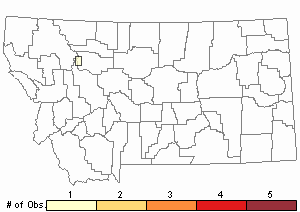
Recency
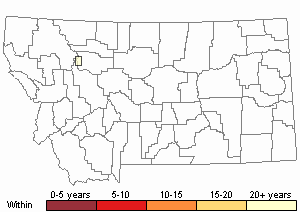
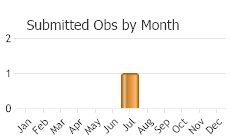
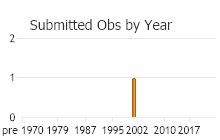
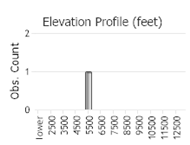 (Observations spanning multiple months or years are excluded from time charts)
(Observations spanning multiple months or years are excluded from time charts)
Habitat
Nymphs generally occur in small, fast-moving streams and require high water quality. Individuals have been encountered at elevations between 555-1255 m in north Idaho (Idaho Department of Environmental Quality Beneficial Use Reconnaissance Program Database). This species occurs in creeks and small streams (Baumann et al. 1977; NatureServe 2006). The trophic relationship of P. expansa is likely a predator (mainly on Chironmidae and Simulidae) as are most other Perlodidae in this sub-family (Merritt and Cummins 1996).
Food Habits
Merritt and Cummins (1996) report that members of the families, Perlidae and Perlodidae, are largely predators eating other aquatic invertrebrates, especially Diptera (Chironomidae and Simuliidae, midges and blackflies) and Mayflies.
Reproductive Characteristics
Baumann et al. (1977) state that adults emerge from July through October across the species’ range. Newell and Minshall (1978) report adult emergence during September at two Idaho locations, and there is often asynchronous emergence of males and females, males emerging first. Drumming, as a means of communication between males and females, has been demonstrated in P. expansa in laboratory reared individuals (Maketon and Stewart 1984).
Management
Pictetiella expansa has no USFWS status at the present time, although it is currently a US Forest Service Species of Concern (SOC); listed as imperiled in Idaho (S2) and unranked in (SNR) in Montana. This species is irregularly distributed in parts of the northern and central Rocky Mountains, and populations have been poorly documented through much of this range (e.g., see Natureserve 2006). Baumann, Gaufin, and Surdick (1977) describe P. expansa as "uncommon." Newell and Minshall (1978) report the species as "rare and restricted in its distribution." More recently, in 1994-1995, the IDDEQ (personal communication 2005) found this species in 22 northern Idaho streams, sometimes in large numbers. The broad west-to-east and north-to-south distribution in Idaho, the number of Idaho streams from which this species has been collected, and the numbers of specimens collected per station by the IDDEQ indicate this species might not be as rare or uncommon in Idaho as earlier publications suggest. Field inventories are needed to learn more about the status and distribution in the Northern Region 1 managed forest lands.
Stewardship Responsibility
Threats or Limiting Factors
Specific threats to populations of P. expansa have not been identified. In general, stonefly populations are affected by changes to aquatic habitat, such asalteration of flow patterns, streambed substrate, thermal characteristics, and water quality. Degradation of riparian and aquatic habitats is the primary concern for population occurring within USFS Region 1.
References
- Literature Cited AboveLegend:
 View Online Publication
View Online Publication Baumann, R.W, A.R. Gaufin, and R.F. Surdick. 1977. The stoneflies (Plecoptera) of the Rocky Mountains. American Entomological Society, Philadelphia.
Baumann, R.W, A.R. Gaufin, and R.F. Surdick. 1977. The stoneflies (Plecoptera) of the Rocky Mountains. American Entomological Society, Philadelphia. Cummins, K.W. and R.W. Merritt. 1996. Ecology and distribution of aquatic insects. Chapter 6, pages 74-86 in R.W. Merritt and K.W. Cummins (eds.) An Introduction to the Aquatic Insects of North America. Third Edition. Kendall/Hunt Publishing Company, Dubuque, Iowa. 862 pp.
Cummins, K.W. and R.W. Merritt. 1996. Ecology and distribution of aquatic insects. Chapter 6, pages 74-86 in R.W. Merritt and K.W. Cummins (eds.) An Introduction to the Aquatic Insects of North America. Third Edition. Kendall/Hunt Publishing Company, Dubuque, Iowa. 862 pp. Maketon, M., and K.W. Stewart. 1984. Drumming behavior in four North American Perlodidae (Plecoptera) species. Annals of the Entomological Society of America 77(5): 621-626.
Maketon, M., and K.W. Stewart. 1984. Drumming behavior in four North American Perlodidae (Plecoptera) species. Annals of the Entomological Society of America 77(5): 621-626. NatureServe. 2006. NatureServe Explorer: An on-line encyclopedia of life [web application]. Version 4.7. Arlington, Virginia.
NatureServe. 2006. NatureServe Explorer: An on-line encyclopedia of life [web application]. Version 4.7. Arlington, Virginia. Newall, R.L., and G.W. Minshall. 1978. An annotated list of the aquatic insects of southeastern Idaho. Part III. (Ephemeroptera). Great Basin Naturalist 38(1): 55-58.
Newall, R.L., and G.W. Minshall. 1978. An annotated list of the aquatic insects of southeastern Idaho. Part III. (Ephemeroptera). Great Basin Naturalist 38(1): 55-58. Stark, B.P. and B.C. Kondratieff. 2004. Pictetiella lechleitneri (Plecoptera: Perlodidae), a new species from Mount Rainier National Park, Washington, U.S.A. Proceedings of the Entomological Society of Washington 106(4): 747-750.
Stark, B.P. and B.C. Kondratieff. 2004. Pictetiella lechleitneri (Plecoptera: Perlodidae), a new species from Mount Rainier National Park, Washington, U.S.A. Proceedings of the Entomological Society of Washington 106(4): 747-750.
- Additional ReferencesLegend:
 View Online Publication
View Online Publication
Do you know of a citation we're missing? Gustafson, D. L. 1990. Ecology of aquatic insects in the Gallatin River drainage. Ph.D. Dissertation. Bozeman, MT: Montana State University. 194 p.
Gustafson, D. L. 1990. Ecology of aquatic insects in the Gallatin River drainage. Ph.D. Dissertation. Bozeman, MT: Montana State University. 194 p.
- Web Search Engines for Articles on "Autumn Springfly"
- Additional Sources of Information Related to "Insects"





